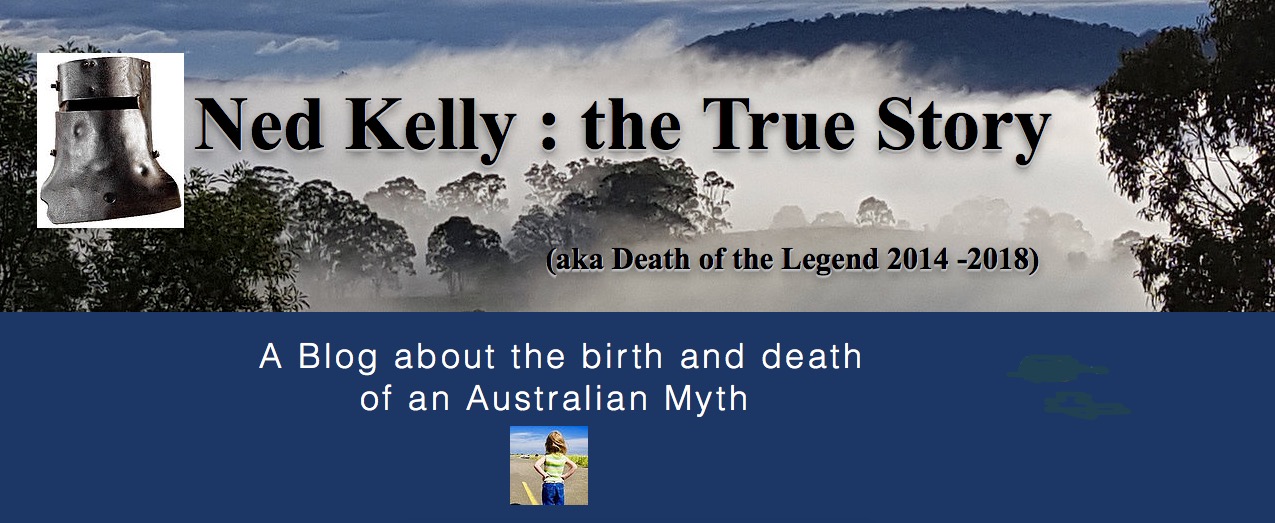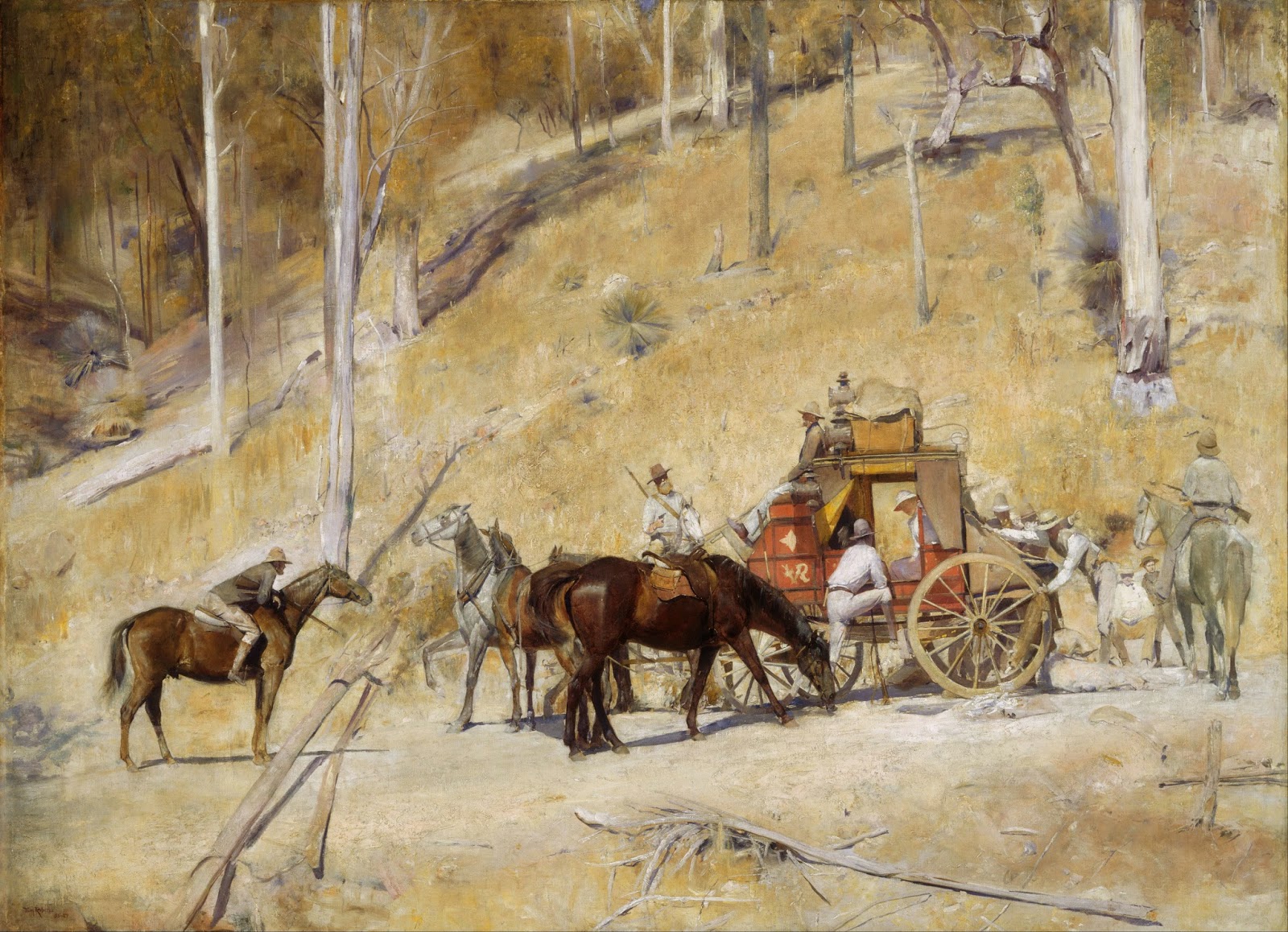The idea that Ned Kelly didn’t get a fair
trial is a core belief of Kelly fanatics, who maintain that he shouldn’t have
been hanged for the killing of Lonigan at Stringybark Creek because Kelly shot
him in self defence; it was Kill or be Killed! The Fanatics claim Ned Kellys
problem was that he had an inexperienced Lawyer defending him, he didn’t
attempt to defend himself , that McIntyre told lies in the Courtroom and the
Judge had it in for him in any case. If only Ned Kelly had a proper Lawyer, or
more time or had taken the opportunity to do what he said he could do if given
a chance, and tell the story from his perspective and persuade the Jury of his
innocence! If only…..and then it all would have been different for our dear
Ned!
Recently I watched the Sixty Minutes
episode from 15 years ago where they
recreated the Trial of Ned Kelly and gave him a proper lawyer and the opportunity to state his own
case to the Jury. It was preceeded by an interview with “Australias leading Kelly expert” Ian Jones – of course! Jones remarks would certainly have
coloured the average viewers perception of the story with such contentious lines as
“I
would trust Ned Kelly with my life”
and Ned was
“ a very brave man, a very honest
man in his way”
and
“ a man who was drawn, or let himself be drawn into a chain
of events that led to his outlawry”
Quite inaccurately – as to be expected from
commercial TV I suppose – the narrator says the proceeds of the Bank robberies
“were given away, Robin Hood style, to the Poor”
and says of Judge Barry that
he
“sentenced one of Kellys uncles to be hanged” which is true, but not the
whole story by any means. The drunk uncle burned down the Kelly house in the
middle of the night, fortunately incinerating no-one, but making a large family
of children homeless. On appeal, his sentence was reduced to a long term of
imprisonment but those facts mess up the poor persecuted Kelly narrative
beloved of Kelly fanatics and dumb 60 Minutes journalists!
As for the Mock Trial itself : now we have
an incompetent Prosecutor in the form of Julian Burnside, an emotive and silly
oration from Ned, a smug Kate Kelly and a defence based on the 20th
century hoax about leather straps. So naturally, Ned is acquitted.
But I wonder if the Fanatics ever do think about
what exactly would have happened if Ned Kelly’s defense had been successful,
and he had been found not guilty in 1880 ?
I have NEVER seen any discussion of this scenario, the one they dream
about fondly, because I suspect, whenever they think about it they realize it
gets them nowhere. They would be like would-be Jail escapees who emerge
blinking excitedly into the bright sunshine from their carefully dug tunnel and find to their
horror they are still in the middle of their prison!
The awful
truth for the Fanatics is that the ultimate outcome would have been the same :
acquittal of the Murder of Lonigan would have soon been followed by Trial for
the murder of Kennedy, he would have been found guilty and of course would have
been hanged for murdering Kennedy. Even Ian Jones believes this, but of course
nobody ever talks about it.
But in a Trial for the Murder of Kennedy,
Ned would not have been able to plead ignorance of who it was he was shooting;
he would not have been able to plead self defence; he would not have been able
to claim it was “Kill or be Killed” because Kennedy was trying to get away,
Kennedy was unarmed and wounded, defenceless, when Ned Kelly shot him at point
blank range.
Another thought has occurred to me as well,
about this killing, something that I haven’t read elsewhere that I would be
interested to hear others thoughts on. Its about the peculiar thing that is supposed to have
happened after he was dead : Ned Kelly covered him with his cloak. Its said
that someone returned to the camp to get Kennedys cloak and cover him with it as
some sort of sign of respect. The odd thing of course is that this same respect
wasn’t shown towards the other two dead police who were right at the camp
itself. And why, if it was a sign of respect were Kennedys possessions stolen from his corpse, along with those from the other dead Police? Surely its the grossest disrespect imaginable to rifle through the pockets and flog the watch of a dead Policeman? I don’t buy the Mythology on this one. None of it really makes sense.
My suggestion is this: Kennedys cloak was
retrieved because he was not fatally wounded, and to start with the plan was to
leave him there, alive , as night fell and the air grew cold, perhaps to survive long enough to
be rescued. They retrieved his cloak because he was alive – the others didn’t
get cloaks because they were dead. Its also known that Kennedy was alive and
lucid enough to not only converse with the Gang but also to write a letter to
his wife in his notebook, the notebook that was subsequently recovered with
pages ripped out of it. In the end though, the psychopath’s lack of empathy for
fellow human beings trumped the other gang members humanity and Kennedy was
silenced, like an ISIS Hostage pleading for his life, the retrieved cloak
thrown over to cover the ghastly sight of his shattered torso. Later of course the psychopath elaborated a story to
Without a doubt, Ned Kelly was destined for
the Gallows. Re-enactments of the trial he did get, manipulated to get him an
acquittal achieve almost nothing, except perhaps to highlight possible deficiencies
in the process. What would be really interesting though, would be to recreate
another trial Kelly didn’t get, the one for the murder of Kennedy. Then,
everyone would realize that in the end, albeit by imperfect means, when Kelly
was hanged Justice was done.





